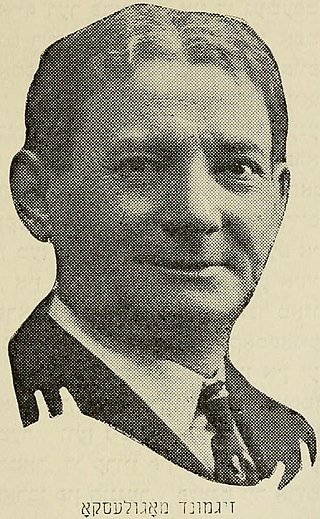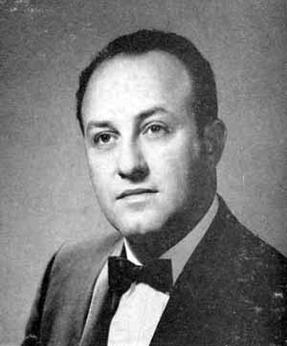Related Research Articles

Moishe Oysher was an American cantor, recording artist, and film and Yiddish theatre actor. During the 1940s and 1950s he was one of the top Hazzans and his recordings continue to be appreciated due to his rich, powerful voice and creative arrangements.

Sigmund Mogulesko — Yiddish: זעליק מאָגולעסקאָZelik Mogulesko, first name also sometimes spelled as Zigmund, Siegmund, Zelig, or Selig, last name sometimes spelled Mogulescu — was a singer, actor, and composer in the Yiddish theater in New York City. He was born in Kalarash, Bessarabia and began singing in the local synagogue choir. Before reaching adolescence, he was paid nearly three times what teachers made, to sing in the synagogue of Chişinău. Soon after moving to Bucharest, Romania, he was paid to sing in churches as well as synagogues, and started acting.
Yiddish song is a general description of several genres of music sung in Yiddish which includes songs of Yiddish theatre, Klezmer songs, and "Yiddish art song" after the model of the German Lied and French mélodie.

Sholom Secunda was an American composer of Ukrainian-Jewish descent, best known for the tunes of "Bei Mir Bistu Shein" and "Donna Donna".
Jewish music is the music and melodies of the Jewish people. There exist both traditions of religious music, as sung at the synagogue and in domestic prayers, and of secular music, such as klezmer. While some elements of Jewish music may originate in biblical times, differences of rhythm and sound can be found among later Jewish communities that have been musically influenced by location. In the nineteenth century, religious reform led to composition of ecclesiastic music in the styles of classical music. At the same period, academics began to treat the topic in the light of ethnomusicology. Edwin Seroussi has written, "What is known as 'Jewish music' today is thus the result of complex historical processes". A number of modern Jewish composers have been aware of and influenced by the different traditions of Jewish music.
For the purposes of this article, “contemporary” refers to the period from 1967 to the present day, “Jewish” refers to the various streams and traits of Judaism practiced. Many Orthodox Jews use the term “religious” to refer to a strict adherence to Jewish law. For the purposes of this article, “religious” refers to the content and context of the music itself: liturgical or implicit references to the divine.
Meir Finkelstein is a cantor and composer of contemporary Jewish liturgical music. He has composed more than 200 settings for the liturgy, as well as scored numerous television programs, made-for-TV movies, and documentary films. His tunes are sung in many Conservative, Reform, and Reconstructionist congregations. He is considered one of the most popular contemporary Jewish liturgical composers in the United States.
Benzion Miller is a cantor, schochet and mohel (circumciser), as was his father, Aaron Daniel Miller. He was born in a displaced persons camp in Fernwald, Germany.

Congregation Beth Israel is a Reform Jewish congregation and synagogue, located at 10460 North 56th Street in Scottsdale, Arizona, in the United States. Incorporated in 1920, the congregation affiliated with the Union for Reform Judaism in 1935.
The Jewish art music movement began at the end of the 19th century in Russia, with a group of Russian Jewish classical composers dedicated to preserving Jewish folk music and creating a new, characteristically Jewish genre of classical music. The music it produced used Western classical elements, featuring the rich chromatic harmonies of Russian late Romantic music, but with melodic, rhythmic and textual content taken from traditional Jewish folk or liturgical music. The group founded the St. Petersburg Society for Jewish Folk Music, a movement that spread to Moscow, Poland, Austria, and later Palestine and the United States. Although the original society existed formally for only 10 years, its impact on the course of Jewish music was profound. The society, and the art music movement it fostered, inspired a new interest in the music of Eastern European Jewry throughout Europe and America. It laid the foundations for the Jewish music and Klezmer revival in the United States, and was a key influence in the development of Israeli folk and classical music.

Es brent is a Yiddish poem–song written in 1936 by Mordechai Gebirtig. Es Brent is generally said to have been written in response to the Przytyk Pogrom of 1936. After the Holocaust, the song was also often used in Holocaust commemoration or in programmes of World War II Ghetto music, both in the original Yiddish and in Hebrew translation. Although Gebirtig wrote prolifically, Es Brent became his best-known composition.

Mordecai Hershman was a Ukrainian-born American Jewish cantor ("chazzan") and singer.
The Milken Archive of Jewish Music is a collection of material about the history of Jewish Music in the United States. It contains roughly 700 recorded musical works, 800 hours of oral histories, 50,000 photographs and historical documents, an extensive collection of program notes and essays, and thousands of hours of video footage documenting recording sessions, interviews, and live performances.

Seymour Schwartzman was an American cantor and opera singer. He was a principal baritone at New York City Opera where he sang over thirty roles and also performed internationally in opera houses and on the concert stage. Among the synagogues where he served as cantor was the Beth Sholom Congregation in Elkins Park, Pennsylvania.
David Nowakowsky (1848-1921) was a Russian/Ukrainian Jewish composer, choirmaster and music teacher. Along with several contemporaries, Nowakowsky integrated traditional Jewish liturgical modes with western harmonies and styles, reinvigorating music for the synagogue. He was also noted as the music director and choirmaster of the Brody Synagogue in Odessa for 50 years. His work is not well known today although he is mentioned in Ira Gershwin's song, Tschaikowsky .

Joseph Rumshinsky (1881–1956) was a Jewish composer born near Vilna, Lithuania. Along with Sholom Secunda, Alexander Olshanetsky and Abraham Ellstein, he is considered one of the "big four" composers and conductors of American Yiddish theater.

Cantor Yitzchak Meir Helfgot is an Israeli-born Hasidic Orthodox Jewish cantor, known for his vocal dexterity and range. Like some operatic tenors he is capable of sustaining long passages in the difficult uppermost tessitura, while also possessing overt technical facility in executing ornate melismas.
Pierre Pinchik, born Pinchas Segal, was a famous Hazzan from the period of the Cantorial golden age. He was also a composer of cantorial and Yiddish music and a singer of Yiddish folk songs. He especially known for his versions of Rozo D'shabbos and Ribono Shel Olom.

Joseph Brody was an American Jewish composer who wrote for the Yiddish theatre as well as liturgical Jewish works. He taught George Gershwin and was a friend of Yossele Rosenblatt. His daughter, Estelle Brody, was an actress.

Shlomo Simcha Sufrin, better known as Shlomo Simcha is a UK-born Canadian Hasidic Jewish cantor and singer. Shlomo Simcha began his career in a small kollel in Montreal, where he was discovered by a local wedding band leader who brought him onto a project recording a series for children in the Satmar community called Besof Umachol. His work on the series caught the attention of Mendy Werdyger at Aderet Records, who introduced him to producer Sheya Mendlowitz, with whom he would create his first commercial album.
References
- ↑ Cantor Louis Danto Bel Canto Archived 2016-03-03 at the Wayback Machine
- ↑ Cantor remembered for musical talent and giving nature, Canadian Jewish News [ permanent dead link ]
- ↑ The greatest cantorial voices of all times
- ↑ Cantor remembered for musical talent and giving nature, Canadian Jewish News [ permanent dead link ]
- ↑ Obituary, Cleveland Jewish News,Cantor Louis Danto was 81